Top 10
Peruvian Woman of Means
By ROGER ATWOOD
Monday, December 12, 2016
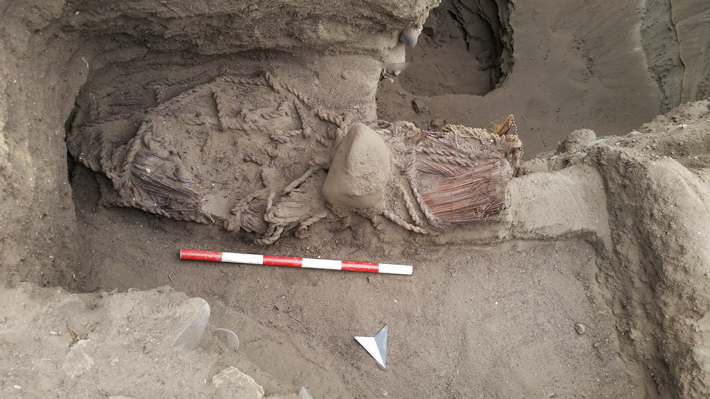
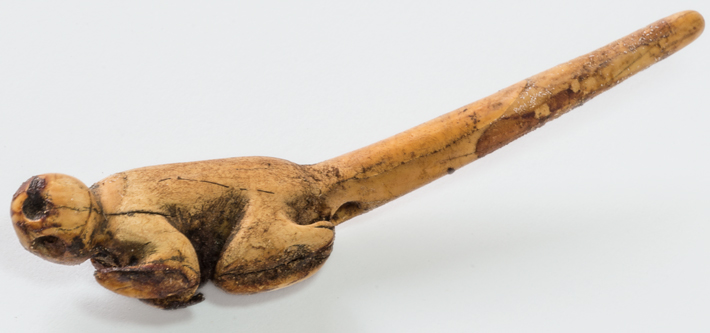 The role of women in ancient cultures has received increased attention in recent years, from that of female pharaohs in Egypt to Viking wives in northern Europe. And now, archaeologists in Peru have found signs that women there held positions of prestige at the earliest stages of civilization. At the site of Áspero, a female skeleton was found decorated with shells of the genus Spondylus, which come from hundreds of miles away in far northern Peru and were a sign of authority for centuries in Andean cultures. About 45 years old when she died, the woman had clothing accessories made of bone carved in the form of seabirds and Amazonian monkeys, also status symbols, says archaeologist Ruth Shady Solís of San Marcos University. Most striking is the burial’s age—some 4,600 years ago, near the dawn of the fishing and farming civilization that thrived on Peru’s coast. Shady Solís found sculpted female figurines dating from the same period—more proof, she believes, that women occupied prominent social positions.
The role of women in ancient cultures has received increased attention in recent years, from that of female pharaohs in Egypt to Viking wives in northern Europe. And now, archaeologists in Peru have found signs that women there held positions of prestige at the earliest stages of civilization. At the site of Áspero, a female skeleton was found decorated with shells of the genus Spondylus, which come from hundreds of miles away in far northern Peru and were a sign of authority for centuries in Andean cultures. About 45 years old when she died, the woman had clothing accessories made of bone carved in the form of seabirds and Amazonian monkeys, also status symbols, says archaeologist Ruth Shady Solís of San Marcos University. Most striking is the burial’s age—some 4,600 years ago, near the dawn of the fishing and farming civilization that thrived on Peru’s coast. Shady Solís found sculpted female figurines dating from the same period—more proof, she believes, that women occupied prominent social positions.
10,000-Year-Old Turf War
By NIKHIL SWAMINATHAN
Monday, December 12, 2016
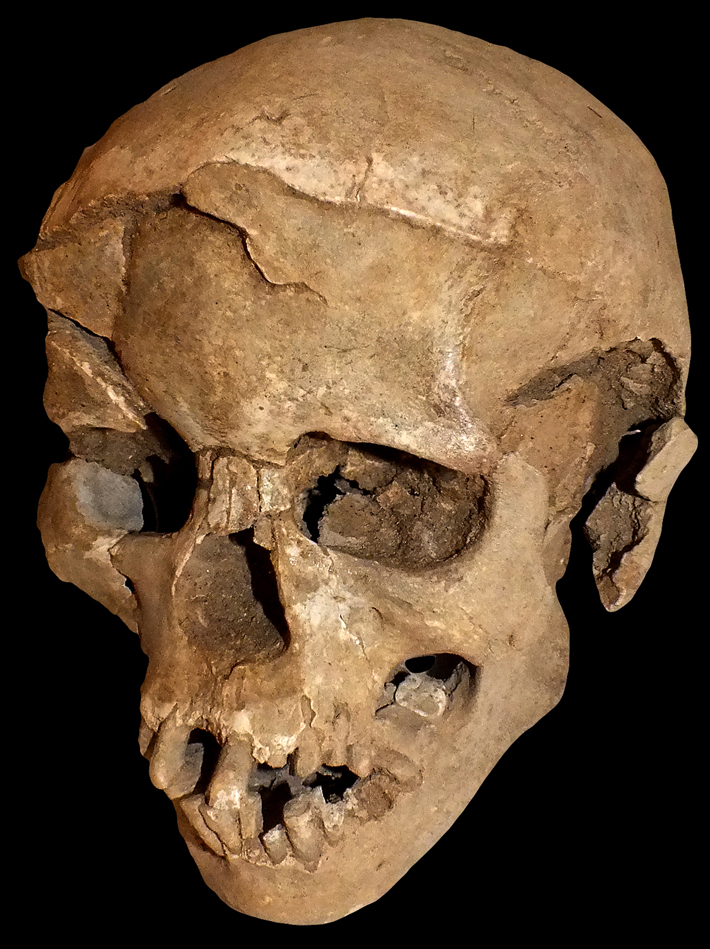 Organized aggression is typically associated with disputes over ownership of land or possessions. But the 10,000-year-old remains of 27 individuals discovered at what was once the southwestern edge of Kenya’s Lake Turkana suggest that this may not always have been the case. The unburied bodies, found at a site called Nataruk, were of hunter-gatherers and were unaccompanied by evidence of settlements or valuables. Instead, they paint a picture of pure carnage: The bones of 21 adults and six children show lesions most likely resulting from arrows and clubs. Weapons found at the site were made from obsidian sourced from afar, indicating the attackers were not local.
Organized aggression is typically associated with disputes over ownership of land or possessions. But the 10,000-year-old remains of 27 individuals discovered at what was once the southwestern edge of Kenya’s Lake Turkana suggest that this may not always have been the case. The unburied bodies, found at a site called Nataruk, were of hunter-gatherers and were unaccompanied by evidence of settlements or valuables. Instead, they paint a picture of pure carnage: The bones of 21 adults and six children show lesions most likely resulting from arrows and clubs. Weapons found at the site were made from obsidian sourced from afar, indicating the attackers were not local.
University of Cambridge archaeologist Marta Mirazon Lahr believes that people have always been prepared to fight for what they want, and that the formation of groups results in cultural divisions, thereby justifying warfare. These preconditions for battle “have existed for a very long time,” she says, “independent of the development of farming, material wealth, civilizations, and social hierarchies.” Within this context, the simple choice to hunt or feast on the beach at Nataruk, a plum spot on a lake almost fully encircled by mountains, where animals came for food and water, could have sealed the deceased’s fate.
Antikythera Man
By JASON URBANUS
Monday, December 12, 2016
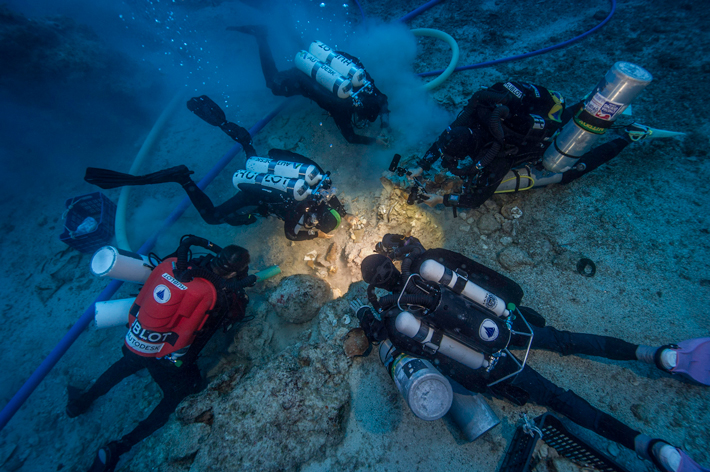
The Antikythera shipwreck (circa 65 B.C.) is the ancient world’s largest, richest, and perhaps most famous wreck. Discovered in 1900 off the Greek island of Antikythera, the site has yielded hundreds of treasures, including bronze and marble statues, as well as the Antikythera Mechanism, often referred to as the world’s oldest computer. However, an important new discovery was made in summer 2016 when an international team recovered a human skeleton there. The remains, which include parts of the cranium, jaw, teeth, ribs, and long bones of the arms and legs, most likely belonged to a young male. Evidence of at least four other individuals had previously been found at the site, but the newly discovered remains are the first to be uncovered in almost 40 years—and during the age of DNA analysis. According to ancient DNA expert Hannes Schroeder, the discovery might provide the first opportunity to examine the genetics of an ancient mariner. “Human remains from ancient shipwrecks are extremely uncommon,” he says. “DNA analyses can potentially provide fascinating new information on the crew’s genetic ancestry and geographic origins.”
Project codirector Brendan Foley suggests that the individual may have been trapped belowdecks when the ship smashed into the rocks and sank. Parts of the skeleton discovered in 2016 remain in situ and will be further excavated this summer. Foley believes that even more human remains may survive at the site along with other precious cargo.
Spiritual Meeting Ground
By ERIC A. POWELL
Monday, December 12, 2016
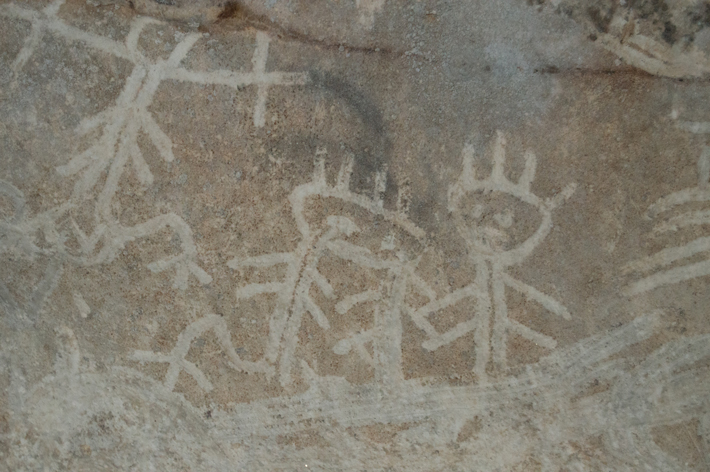
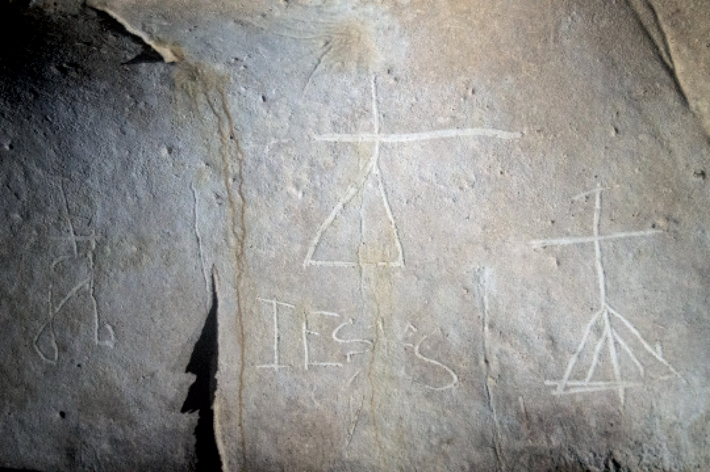 Since at least the twelfth century, indigenous Taino people living on Mona, a small island west of Puerto Rico, ventured deep into its vast network of caves and left images of cemies, or deities, on the chambers’ soft limestone walls. Now a team led by Alice Samson of the University of Leicester and British Museum archaeologist Jago Cooper has found that one of the caves also contains markings left by sixteenth-century Spaniards. “The entrance to this cave is quite difficult to find,” says Cooper. “So the Europeans were probably, at least initially, led there by Taino.” The team has recorded more than 30 historic inscriptions, including crosses, Latin phrases from the Bible, and even the signatures of individuals, such as a sixteenth-century royal official named Francisco Alegre, who had jurisdiction over Mona at one time.
Since at least the twelfth century, indigenous Taino people living on Mona, a small island west of Puerto Rico, ventured deep into its vast network of caves and left images of cemies, or deities, on the chambers’ soft limestone walls. Now a team led by Alice Samson of the University of Leicester and British Museum archaeologist Jago Cooper has found that one of the caves also contains markings left by sixteenth-century Spaniards. “The entrance to this cave is quite difficult to find,” says Cooper. “So the Europeans were probably, at least initially, led there by Taino.” The team has recorded more than 30 historic inscriptions, including crosses, Latin phrases from the Bible, and even the signatures of individuals, such as a sixteenth-century royal official named Francisco Alegre, who had jurisdiction over Mona at one time.
Cooper says that while the European inscriptions were placed close to the indigenous markings, they don’t overlap, leaving the impression that the Spaniards were careful not to deface the Taino rock art. “It’s as if the two traditions were in dialogue with one another,” says Cooper, noting that it is also possible that Taino who had converted to Christianity made some of the crosses. “This is tangible evidence of how people, both European and indigenous, were forging new identities in the Americas. The cave embodies the personal experience of contact between these two cultures.”
Salem’s Lost Gallows
By SAMIR S. PATEL
Monday, December 12, 2016
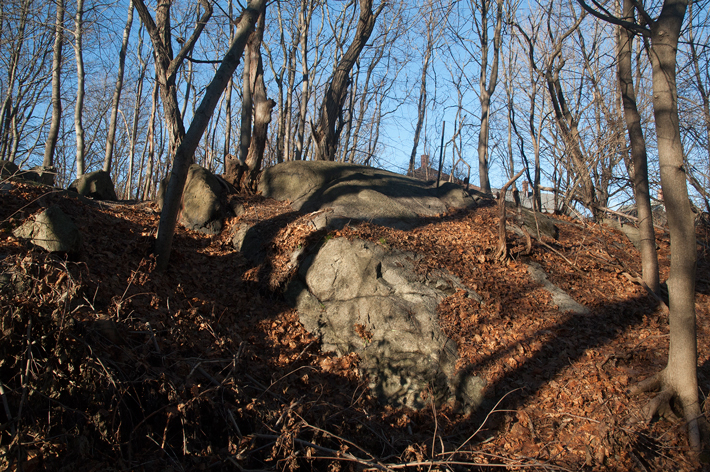
There are almost 1,000 surviving official documents and several contemporary histories from the Salem witch trials of 1692 and 1693. But little of this relates directly to the 19 hangings that punctuated the notorious period of hysteria and paranoia, and none of the documents record where the executions took place.
The site—long believed to have been somewhere on or near Gallows Hill—appears to have been forgotten by the early nineteenth century. In 1921, historian Sidney Perley theorized that the hangings took place at Proctor’s Ledge, a rocky outcrop at the base of Gallows Hill.
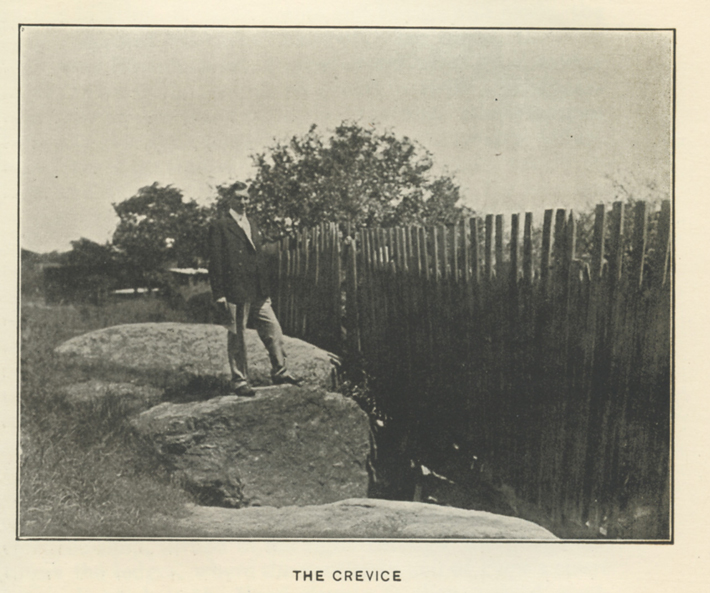 Over the last five years, a research team has reviewed Perley’s findings. They have also applied new technology to pinpoint the site.
Over the last five years, a research team has reviewed Perley’s findings. They have also applied new technology to pinpoint the site.
With the help of both a piece of overlooked testimony and a geographic information system that determined what could be seen from where (known as a viewshed analysis), researchers concluded in 2016 that Perley had been right. Proctor’s Ledge is indeed the spot where the accused met their ends. The team, led by Salem State University historical archaeologist Emerson Baker, also conducted geophysical testing and found no human remains or evidence of a gallows at the site. “This finding is in keeping with oral traditions,” Baker says, “that the families of the victims came under cover of darkness to recover loved ones and rebury them in family cemeteries.”
Advertisement
Advertisement
IN THIS ISSUE
Advertisement

Recent Issues
-
 May/June 2024
May/June 2024
-
 March/April 2024
March/April 2024
-
 January/February 2024
January/February 2024
-
 November/December 2023
November/December 2023
-
 September/October 2023
September/October 2023
-
 July/August 2023
July/August 2023
-
 May/June 2023
May/June 2023
-
 March/April 2023
March/April 2023
-
 January/February 2023
January/February 2023
-
 November/December 2022
November/December 2022
-
 September/October 2022
September/October 2022
-
 July/August 2022
July/August 2022
-
 May/June 2022
May/June 2022
-
 March/April 2022
March/April 2022
-
 January/February 2022
January/February 2022
-
 November/December 2021
November/December 2021
-
 September/October 2021
September/October 2021
-
 July/August 2021
July/August 2021
-
 May/June 2021
May/June 2021
-
 March/April 2021
March/April 2021
-
 January/February 2021
January/February 2021
-
 November/December 2020
November/December 2020
-
 September/October 2020
September/October 2020
-
 July/August 2020
July/August 2020
-
 May/June 2020
May/June 2020
-
 March/April 2020
March/April 2020
-
 January/February 2020
January/February 2020
-
 November/December 2019
November/December 2019
-
 September/October 2019
September/October 2019
-
 July/August 2019
July/August 2019
-
 May/June 2019
May/June 2019
-
 March/April 2019
March/April 2019
-
 January/February 2019
January/February 2019
-
 November/December 2018
November/December 2018
-
 September/October 2018
September/October 2018
-
 July/August 2018
July/August 2018
-
 May/June 2018
May/June 2018
-
 March/April 2018
March/April 2018
-
 January/February 2018
January/February 2018
-
 November/December 2017
November/December 2017
-
 September/October 2017
September/October 2017
-
 July/August 2017
July/August 2017
-
 May/June 2017
May/June 2017
-
 March/April 2017
March/April 2017
-
 January/February 2017
January/February 2017
-
 November/December 2016
November/December 2016
-
 September/October 2016
September/October 2016
-
 July/August 2016
July/August 2016
-
 May/June 2016
May/June 2016
-
 March/April 2016
March/April 2016
-
 January/February 2016
January/February 2016
-
 November/December 2015
November/December 2015
-
 September/October 2015
September/October 2015
-
 July/August 2015
July/August 2015
-
 May/June 2015
May/June 2015
-
 March/April 2015
March/April 2015
-
 January/February 2015
January/February 2015
-
 November/December 2014
November/December 2014
-
 September/October 2014
September/October 2014
-
 July/August 2014
July/August 2014
-
 May/June 2014
May/June 2014
-
 March/April 2014
March/April 2014
-
 January/February 2014
January/February 2014
-
 November/December 2013
November/December 2013
-
 September/October 2013
September/October 2013
-
 July/August 2013
July/August 2013
-
 May/June 2013
May/June 2013
-
 March/April 2013
March/April 2013
-
 January/February 2013
January/February 2013
-
 November/December 2012
November/December 2012
-
 September/October 2012
September/October 2012
-
 July/August 2012
July/August 2012
-
 May/June 2012
May/June 2012
-
 March/April 2012
March/April 2012
-
 January/February 2012
January/February 2012
-
 November/December 2011
November/December 2011
-
 September/October 2011
September/October 2011
-
 July/August 2011
July/August 2011
-
 May/June 2011
May/June 2011
-
 March/April 2011
March/April 2011
-
 January/February 2011
January/February 2011
Advertisement






